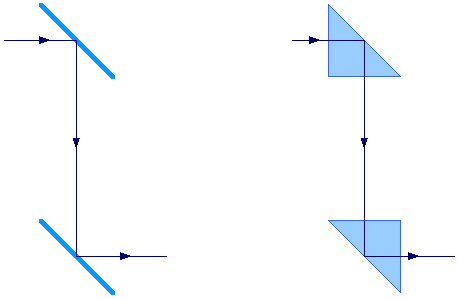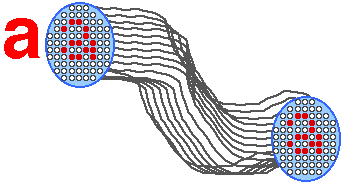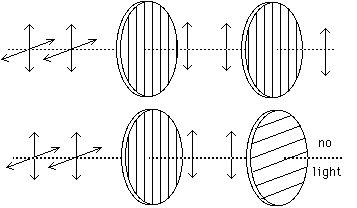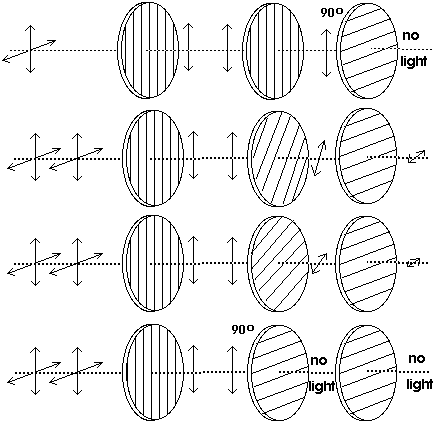

Reflection and Refraction
(this is Chapter 16 of Adventures in Physics, available only online)
Ch 16, Reflection and Refraction; 1, 3, 6, 8, 10, 15, 16, 18, 19, 22
![]()
1. 1. You can often see some of the details in the dark portion of a crescent moon. Where does the light come from that allows you to see this?
This light might be called "Earth shine" for it is light that has been reflected first from Earth to illuminate the dark portion of our moon and then reflected back for us to see.
3. After Thomas Young's famous double-slit experiment, people regarded light as a wave. What made Young's ideas about light different -- and more compelling -- than Huygens' ideas?
Young had experimental evidence. Huygens had an idea but it required Young to provide the experimental evidence that light is, indeed, a wave.
6. Light and television or radio waves are all electromagnetic waves and travel with the same speed. Television often uses communications satellites that orbit about 35,000 km above Earth's surface. How can this explain the lag sometimes seen as a TV interviewer talks with someone at a remote location?
It requires some time for a TV signal to leave the newscaster who asks a question, travel to a communications satellite, travel back down to the person answering the question, and then retrace its path for the answer.
10. Is light bent toward or away from the normal as it passes from air (n = 1.00) into ethyl alcohol (n = 1.36)?
In going from air into alcohol, the light is bent toward the normal.
15. Make a sketch of how you could arrange two prisms to make a periscope that would allow you to see over taller people in a crowd or to see around a corner. It may help to start with a sketch using mirrors and then replace the mirrors with prisms.

16. As light is reflected and bounces around a single fiber optic, it becomes all jumbled up. A single fiber optic--or "light pipe"--will not produce a clear image. How, then, can a clear image be seen?
Many, tiny fiber optics are used. They are held in a fixed relative position.
17. If you hold onto the end of a rope and wiggle it up and down you produce a continuous wave that is polarized vertically. You can continue to do this until your arm gets tired. Yet the light from a flashlight is not polarized. Why not?
Each "piece" of light -- called a "photon" -- comes from a different atom. Each atom sends out a little "piece" of light that is independent of the "piece" of light that comes from any other atom. This means each "piece" of light has a different polarization state from the next "piece" of light. This means the light has a continuous random polarization or that it is unpolarized. We describe this by saying that the light is incoherent (yes, I know you may say that about your instructor, too!).
18. Consider the polarizer and analyzer sketched in Figure 16.24. Describe the intensity of the light passing through the analyzer as the analyzer is rotated a full 360°.

Initially, there is full light.
After rotating 90o, there is no light.
Rotating through another 90o -- or 180o from the initial position -- there is, again, full light.
Rotating through another 90o -- or 270oo from the initial position -- there is, again, no light.
Rotating through another 90o -- or 360o from the initial position -- there is, again, full light.
22. Consider the arrangement of polarizer and analyzer shown in Figure 16.24. Cross the polarizer and analyzer 90o so that no light passes the analyzer. Now insert a third Polaroid sheet between the two. Describe what happens&emdash;how much light passes through the entire system&emdash;as the third and inner Polaroid sheet is rotated a full 360o.
This one is fun -- and not at all what I would expect. Remember, a polarizer does more than just reduce the amount of light that passes through. The light that passes through is also polarized -- in a direction that changes as the final polarizer is rotated.When the third and inner polarizer is rotated 0o and 90o, no light passes through. But, between those two extremes, light does pass through!

We can see that in rotating the third and inner polarizer through 90o, the light goes from no light to some maximum and back to no light that is passed through. This will be the case for each 90o that we rotate this third and inner polarizer.
1. How long does it take light to travel from our Moon to the Earth?
The distance from Earth to our Moon is about 384,403 km (238,857 mi). Round that off to 380,000 km or 3.8 x 105 km or 3.8 x 108 m. The speed of light is 3.0 x 108 m/s. You know that velocity, time, and distance are related byv = s /
t
t =
s / v
t = (3.8 x 108 m) / (3.0 x 108 m/s)
t = 1.3 s
2. Light and television or radio waves are all electromagnetic waves and travel with the same speed. Television often uses communications satellites that orbit about 40,000 km above Earth's surface. How long does it take a TV signal to travel from a transmitter to the communications satellite and back down to a receiver?
The total distance traveled is about 80,000 km or 8 x 104 km or 8 x 107 m. The speed of the EM wave, just like light, is 3 x 108 m/s.v = s /
t
t =
s / v
t = (8 x 107 m) / (3.0 x 108 m/s)
t = 0.27 s
Typical multiple-guess questions:
1. Electromagnetic waves consist of
a) compressions and rarefactions of electromagnetic pulses.b) oscillating electric and magnetic fields.
c) particles of light energy.
d) high-frequency gravitational waves.
2. Electromagnetic waves
a) can travel through a vacuum.b) need a medium to travel through.
3. The main difference between a radio wave and a light wave is its
a) speedb) wavelength
c) EM characteristic
d) all of the above
4. Which of these electromagnetic waves has the shortest wavelength?
a) X-raysb) ultraviolet waves
c) infrared waves
d) radio waves

5. Compared to ultraviolet waves, the wavelength of infrared is
a) longerb) identical
c) shorter
6. Compared to radio waves, the velocity of visible light waves in a vacuum is
a) greaterb) the same
c) less
7. Compared to radio waves, the wavelength of visible light waves in a vacuum is
a) longerb) the same
c) shorter
8. Which of the following is fundamentally different from the others?
a) X-raysb) visible light waves
c) sound waves
d) radio waves
9. If a light signal and a radio signal were emitted simultaneously from Alpha Centauri, the first to reach Earth would be the
a) the radio signalb) the light signal
c) both would arrive at the same time
10. Light travels fastest in
a) waterb) vacuum
c) air
d) glass
11. Refraction, as light goes from air to glass, results from differences in light's
a) frequency in air and glassb) incident angle
c) speed in air and glass
d) all of the above
12. Light refracts when traveling from air into glass because light
a) intensity is greater in air than in glassb) frequency is greater in glass than in air
c) speed is greater in air than in glass
d) polarization is greater in glass than in air
13. A beam of light emerges from water into air at an angle. The beam is bent
a) toward the normalb) away from the normal
c) at an angle of 49°
d) only if it is polarized
14. When a light beam emerges from water into air, the light speed
a) increasesb) remains the same
c) decreases
15. The critical angle for a transparent material is the angle at and beyond which all light within the material is totally
a) absorbedb) reflected
c) refracted
d) polarized
16. In an optical fiber, light actually
a) curves in a direction parallel to the central axis of the fiber.b) travels in straight-line segments.
c) travels along the outer surface of the fiber.
d) all of the above.
17. Light will not pass through a pair of Polaroids when their axes are
a) parallelb) rotated 45°
c) rotated 57°
d) perpendicular
18. Monochromatic light is light of a single
a) colorb) wavelength
c) frequency
d) all of the above
19. In the interference pattern produced by shining a laser through two slits (Young's double slit experiment), the bright areas are the result of
a) destructive interference.b) polarization.
c) constructive interference.
d) restructive construction.
Answers to the typical multiple-guess questions:
1. Electromagnetic waves consist of
a) compressions and rarefactions of electromagnetic pulses.b) oscillating electric and magnetic fields.
c) particles of light energy.
d) high-frequency gravitational waves.
2. Electromagnetic waves
a) can travel through a vacuum.b) need a medium to travel through.
3. The main difference between a radio wave and a light wave is its
a) speed (both have the same speed, 3.0 x 108 m/s)b) wavelength
c) EM characteristic (both are EM waves)
d) all of the above
4. Which of these electromagnetic waves has the shortest wavelength?
a) X-raysb) ultraviolet waves
c) infrared waves
d) radio waves

5. Compared to ultraviolet waves, the wavelength of infrared is
a) longerb) identical
c) shorter
6. Compared to radio waves, the velocity of visible light waves in a vacuum is
a) greaterb) the same (all EM waves have the same speed, 3.0 x 108 m/s)
c) less
7. Compared to radio waves, the wavelength of visible light waves in a vacuum is
a) longerb) the same
c) shorter
8. Which of the following is fundamentally different from the others?
a) X-rays (EM wave requiring no medium)b) visible light waves (EM wave requiring no medium)
c) sound waves (sound is a mechanical wave that requires a medium)
d) radio waves (EM wave requiring no medium)
9. If a light signal and a radio signal were emitted simultaneously from Alpha Centauri, the first to reach Earth would be the
a) the radio signalb) the light signal
c) both would arrive at the same time (all EM waves have the same speed, 3.0 x 108 m/s)
10. Light travels fastest in
a) waterb) vacuum
c) air
d) glass
11. Refraction, as light goes from air to glass, results from differences in light's
a) frequency in air and glassb) incident angle
c) speed in air and glass
d) all of the above
12. Light refracts when traveling from air into glass because light
a) intensity is greater in air than in glassb) frequency is greater in glass than in air
c) speed is greater in air than in glass
d) polarization is greater in glass than in air
13. A beam of light emerges from water into air at an angle. The beam is bent
a) toward the normalb) away from the normal
c) at an angle of 49°
d) only if it is polarized
14. When a light beam emerges from water into air, the light speed
a) increasesb) remains the same
c) decreases
15. The critical angle for a transparent material is the angle at and beyond which all light within the material is totally
a) absorbedb) reflected (total internal reflection)
c) refracted
d) polarized
16. In an optical fiber, light actually
a) curves in a direction parallel to the central axis of the fiber.b) travels in straight-line segments.
(by total internal reflection, light is reflected at the edge of the optic fiber)c) travels along the outer surface of the fiber.
d) all of the above.
17. Light will not pass through a pair of Polaroids when their axes are
a) parallelb) rotated 45°
c) rotated 57°
d) perpendicular
18. Monochromatic light is light of a single
a) colorb) wavelength
c) frequency
d) all of the above
19. In the interference pattern produced by shining a laser through two slits (Young's double slit experiment), the bright areas are the result of
a) destructive interference.b) polarization.
c) constructive interference.
d) restructive construction.
![]()
(C) 2003, Doug Davis; all rights reserved